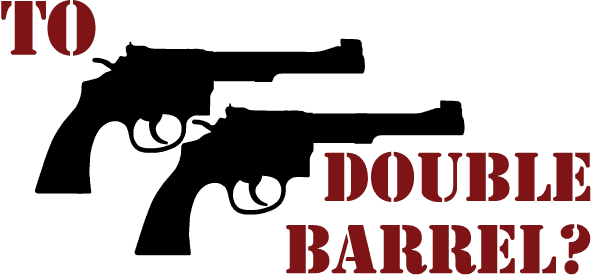“Don’t C-bet unless you have a double barrel plan.”
I heard this once. Honestly, I am not entirely sure where but it is undoubtedly a great piece of advice, and today I have chosen to forward it you guys.
In poker you want to be thinking ahead at all times; in terms of hands, as well as for future potential situations that may arise. Double Barrels are a prime example of this think ahead concept. Chess players are said to be thinking 5 moves ahead at all times. Thankfully, in poker a Double or even Triple Barrels only involve up to three streets, so I’d like to think it is slightly easier.
We won’t touch on Triple Barrels much in this article as they tend to involve specific actions and cards arising at the same time; an alignment of planets if you will. However, we will touch on what makes for a good double barrel and what to look for when deciding to make one.
As always, to help best illustrate the concept we will start with a hand example:
Stakes $2-5 ($1K effective)
Hero is UTG with A♦ K♦ and raises to $25
Folds around
BUT (TAG) calls
Blinds fold
Flop ($57): T♠ 6♣ 3♦
This is a dry board that likely does not hit our opponent. Therefore, a continuation bet will work enough of the time to show a profit in this situation.
Hero Bets $40
BUT Calls $40
Unfortunately, our opponent did not fold. Now what? Well, before we laid out a continuation bet, we should have had a plan for the turn if our opponent were to call. If you currently do not do this in your game, begin to. In other words, we need a Plan B. How else can we win this pot when our opponent does not fold on the flop? This brings me to the topic of this article: Double Barreling.
OK, I tricked you. For this discussion, the actual turn played becomes insignificant, and therefore we won’t finish the hand. However, the decision matrix behind how we will play various turns is, and will lay a solid foundation for all Double Barrel situations in your strategy.
Let us look at what hands our TAG opponent calls our flop bet with:
Flop: T♠ 6♣ 3♦
TAG villain’s flop calling range:
If we analyze our opponent’s range, we find that numerous cards on the turn hurt our opponent’s range as a whole.
Cards such as: Jack, Queen, King, and Ace are generally hurting our opponent’s flop calling range. Therefore, these cards should be shoo-ins to bet either as a bluff or for value (A/K in this situation) on the turn.
Diamond Turn: If we notice our opponent’s range we find that it is filled with numerous middle pocket pairs, and several weak Tx combinations. If we are to bet any diamond turn, we expect our opponent to fold many of his middle pocket pairs. Our opponent views these hands as “call once and fold to further aggression.” type hands. Also, our opponent may incorrectly fold some of his Tx combinations.
Pro Tip: Betting a diamond turn will set up several triple barrel situations.
Therefore, in this hand our double barrel cards are:
Ace (value), King (value), Queen (semi-bluff), Jack (semi-bluff), All diamonds (semi-bluff)
As a rule of thumb, as the cards get bigger they tend to help the original raiser’s range. Contrarily, as cards get lower on the turn and river they tend to help the pre-flop caller’s range. You can use this to your advantage when deciding if a double barrel may be optimal.
It is important to remember that your double barrels are not going to work all the time. In fact, sometimes they will blow up in your face, and your opponent will raise. However, the key question to ask yourself is, “Is my double barrel going to work enough of the times to show a profit in the long run versus this opponent?”. If the answer to this question is yes, and you are executing it on the correct cards, then pull the trigger. If the answer is no, then save your chips.

When we bet one street we want to have a plan for future streets. Executing double barrels requires this prerequisite as well. In short, you want to analyze your opponent’s range when he calls your flop bet, and then keep in mind how future cards are affecting his range. Also, ask yourself if these cards are helping or hurting your perceived range? The answers to these questions will help guide you towards deciding whether or not to unleash more bets.
With practice, the thought process behind a double barrel will become second nature and instilled in your game. Recognizing good versus bad situations to unleash the clip is what will set you apart from the field in this department.

Christian, hi, so helpful thanks. One question: if you include JJs and Qs in our O’s flop calling range, this confused me. Wouldn’t those cards help their calling range? Thanks.
“Cards such as: Jack, Queen, King, and Ace are generally hurting our opponent’s flop calling range. Therefore, these cards should be shoo-ins to bet either as a bluff or for value (A/K in this situation) on the turn.”
Hi Emma.. No, what he is saying that the chances of the J or Q hitting one of the other combos they don’t have is a lot more odds than the Q-Q or J-J. The Q or J favor the original aggressor (which is you) in the hand.
Christian thanks, on second read, you listQQ (not all combos), JJ, T8s-ATs.” First, why not all Q combos? And two, why are the Tx combos you list suited? Wouldn’t an average TAG on the button have called pre with most any Q/10, K/10, A/10 hand, suited or not? Thanks again.